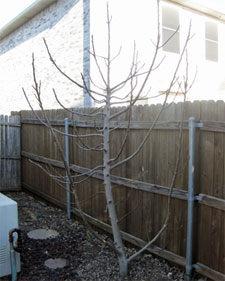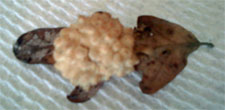Question and Answer – April 2011
If you’d like Neil’s help with a plant question, send it to him along with a photo. He will select those of greatest reader interest, so no plant IDs, please. Remember that Neil requires photos for all questions that are used in e-gardens – be sure you attach one. Click to send your question and photo.

Question: This bed of rhododendrons was beautiful when we bought our new home three years ago, but when we moved into the house last December, it looked like this. We need to replant the bed. We’re in the Piney Woods. Do we need to dig out and replace the soil? The bed gets dappled shade. Is that enough? How can we avoid this in the future with rhododendrons/azaleas? C.S., Scroggins.
Answer: All azaleas are in the genus Rhododendron, but not all plants that gardeners know as "rhododendrons" are azaleas. The large-leafed, huge-flowering rhododendrons of the North, East Coast and, most particularly, the Pacific Northwest don’t do especially well in Texas. These appear, however, to have been regular azaleas, and best guess is that they simply got too dry over the years that your house was empty. Your soils should be fine in terms of pH, so there’s no need to replace the soil entirely, like folks in the black clay soils of Central Texas must do. Take the old azaleas out, rototill to 12 inches, and mix 3 or 4 inches of organic matter into the ground as you till. Your new plants should do fine. Dappled shade serves them very well.

Question: I can’t get bermuda to grow in two shaded areas of my lawn. What groundcover would do best, and how do I get it started? How about grass? S.C., no city given.
Answer: In the heaviest shade of my own trees, I have used mondograss (aka monkeygrass) where the grass just won’t grow. Even St. Augustine, our most shade-tolerant grass, requires at least 4 to 6 hours of sunlight daily to thrive. Where I get less than that, mondograss has covered and spread well. You can walk on it occasionally if you have to, but it’s not really a turfgrass, even though it looks like grass. It has no pest problems, and you don’t have to mow it. You could also use purple wintercreeper euonymus or Asian jasmine if you preferred. Rototill the soil to a depth of 3 or 4 inches, and work 2 or 3 inches of organic matter in prior to planting. Miss as many of the larger roots as possible as you till. As for the grass, St. Augustine would be your best choice for shaded areas, but it does come with baggage. Plant it in April, then keep an eye out for insect and disease problems that could threaten it.

Question: Should I remove some of the side branches of my fig tree? Also, how can I keep a possum out of the tree? It harvested all of my figs last year before I could get there. (Photo taken before tree leafed out.) T.R., Fort Worth.
Answer: Figs really are not trees, but large shrubs with tons of branches. You could certainly remove 2 or 3 of the lowest branches, but you probably shouldn’t try to train it into being a real tree. Actually, they’re huge shrubs that grow to 15 to 20 feet tall and wide. You really don’t want to prune any more than you must. Hopefully, the space you have available for it will be adequate. As for the possum, you can hope it will have moved on by next summer. Otherwise, a humane trap would probably work. Those of us who trap armadillos with those traps often end up capturing possums instead. Good luck!

Question: What is the fuzzy white growth on the backs of many of my oak leaves? Will they hurt the trees? K., Corsicana area.
Answer: Those are wooly oak galls. They’re caused by insects that sting leaves and twigs and deposit eggs. The plant tissues grow around the developing larvae. There is nothing you can do to stop them, nor do they do any harm. No call to action.

Question: You’ll see two eastern redbuds we received as 8-inch trees two years ago from the National Arbor Day Foundation. We want to transplant them to a permanent spot. Should we trim them back so they won’t be so lanky? R. and S. H., Denton area.
Answer: You’ll need to wait until next winter to dig them, as they’ve already started growing for this season. You definitely will want to trim them to help reshape them, but you can’t do much as long as they’re up against the house like this. You might want to remove 12 to 16 inches of their growing tips to encourage them to begin developing side branches. You probably also ought to root-prune them now by cutting their lateral roots all the way around each tree in an 8-inch radius from the trunk.

Question: What is this white residue on my roses (photo taken just before pruning a couple of weeks ago)? M.R., Fort Worth.
Answer: That’s a scale insect, and almost any systemic rose insecticide will kill it. You could use a soil drench type, but many would prefer to spray it with a labeled scale control. Treat now and again as needed into the early summer. It will probably go away fairly quickly.
